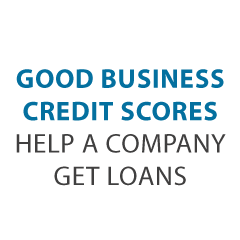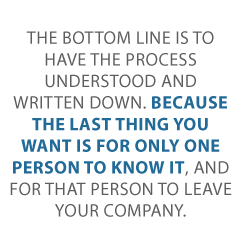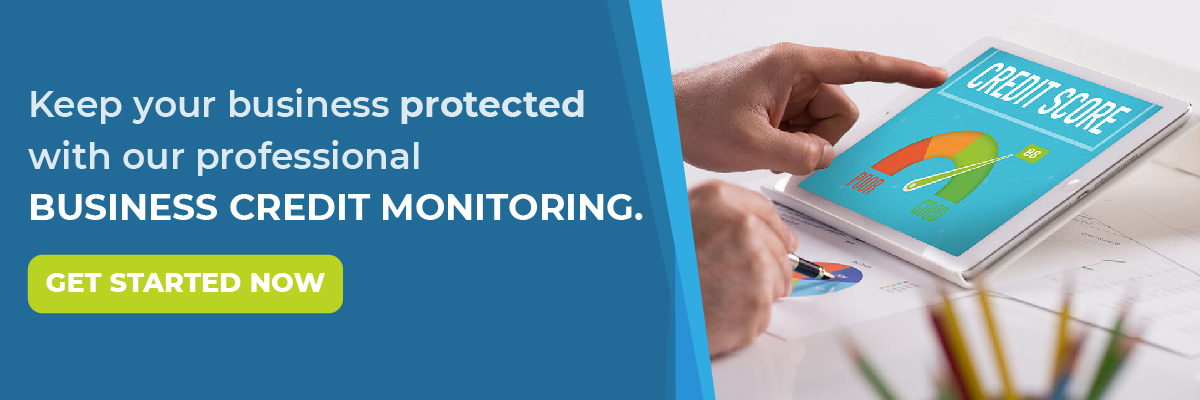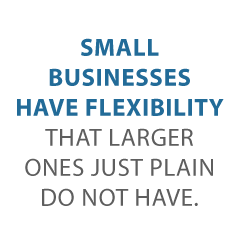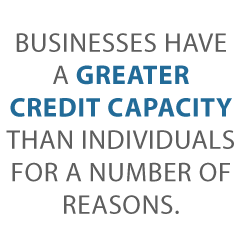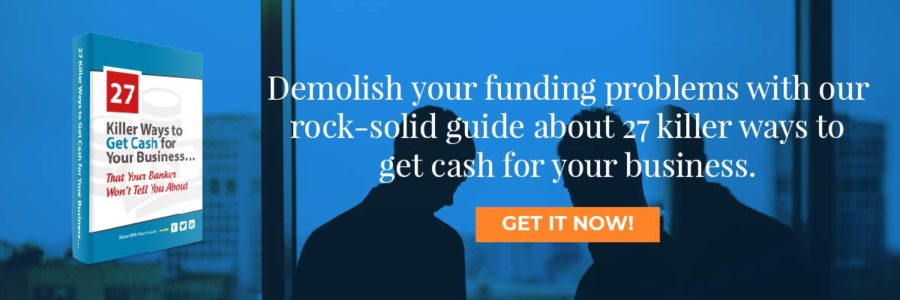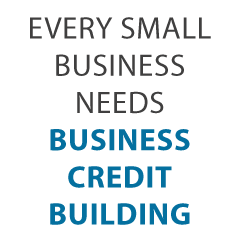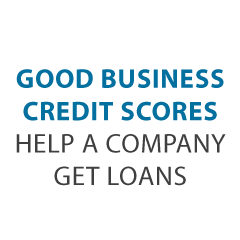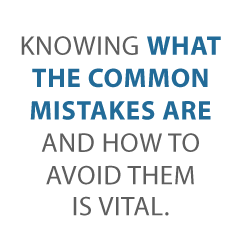
The Best Small Business Credit Card of 2019 for Any Situation
fwistAnd How to Be Sure You are Eligible for the Best Small Business Credit Card for Your Situation
When you start wondering what the best small business credit card is, you may be surprised to find out that answer actually can vary. What may be the best credit card for one business may not necessarily be the best small business credit card for another. It all depends on the business and the situation. For example, a business owner that does a lot of travel for his or her business is going to need a different card than one that has a whole fleet of automobiles to manage but doesn’t travel much.
We have done some research to help you find the best small business credit card to fit your specific needs.
Best Small Business Credit Card When You Want 0% APR
Capital One® Quicksilver® Card
This card features flat-rate rewards of 1.5% on all purchases, and there are no limits on cash back rewards. In addition, there is no yearly fee.
New cardholders have a 0% APR on purchases and balance transfers for the first 15 months after starting the account. Afterwards, the rate increases to 14.74 to 24.74% (variable). A cash bonus of $150 is available for those who make at least $500 on purchases within 3 months of account opening.
Also, cash back rewards do not expire for the life of the account. Other benefits include travel accident insurance and an auto rental collision damage waiver. Find out more by going here.
Best Small Business Credit Card When You Want No Annual Fee
Capital One® Spark® Classic for Business
Try the Capital One Spark Classic for Business. It earns an unlimited 1% cash back on all purchases, and you still get the benefits of an auto rental collision damage waiver and purchase security. You also get extended warranty coverage, as well as travel and emergency assistance services.
However, the ongoing APR is 24.74% variable. The penalty APR is even higher at 31.15%. Another drawback is that there is no sign-up bonus. Find out more here.
Hit the jackpot with our best webinar and its trustworthy list of seven vendors who can help you build business credit.
Best Small Business Credit Card for Students
Discover it® Student Cash Back
Okay, full disclosure. The Discover it® Student Cash Back card is not a business credit card. It’s a personal card, therefore your credit activity is reported on your personal credit and not your business credit. However, as a student, building your FICO will be important to your future as a business owner.
There is a six-month introductory period of 0% APR on purchases. After that, there is an APR of 14.99 to 23.99% variable on all purchases.
One special feature is that it provides an incentive for students to maintain good grades with a $20 statement credit. If students earn a GPA of 3.0 or higher each school year, they get a $20 statement credit per year for up to five years.
You can get 5% cash back at different places each quarter like grocery stores, filling stations, restaurants or Amazon.com up to the quarterly maximum. After that, the credit card offers unlimited 1% cash back on all purchases. Also, in the first year, all cash back rewards are matched 100%.
Although they waive the first late payment fee, a fee of up to $37 applies on all other late payments. There is also a returned payment fee of up to $37. Find more information here.
Best Small Business Credit Card for Mileage Rewards
United MileagePlus Explorer Business Card
Earn 2 miles per dollar with United and at restaurants, filling stations, and office supply stores. All other purchases earn 1 mile per dollar. There is also a 50,000-mile sign-up bonus after spending $3,000 in the first three months from account opening.
Benefits include priority boarding, a free first checked bag for you and a companion on the same reservation. Also, get two United Club passes annually. Hotel and resort perks, including upgrades, are available as well. Additionally, get early check-in and late checkout. An auto rental collision damage waiver is also a benefit.
After the first year, the card has an annual fee of $95. The APR is 17.99% to 24.99%, based on creditworthiness. Find out more here.
Best Small Business Credit Card if You Have Average Credit
Capital One® Spark® Classic for Business
For fair credit, we like the Capital One Spark Classic for Business. It has no yearly fee and cash-back rewards of unlimited 1% cash back on all purchases. Benefits include an auto rental collision damage waiver and purchase security. In addition, extended warranty coverage as well as travel and emergency assistance services are included. Find out more here.
Best Small Business Credit Card if Luxurious Travel is Your Thing
Chase Sapphire Preferred® Card
Earn two points per dollar spent on travel and dining at restaurants, and one point per dollar on all other purchases. Points can be redeemed for cash back, gift cards, or travel. Benefits include trip cancellation insurance, travel and emergency assistance services and an auto rental collision damage waiver. Purchase protection and extended warranty protection are also included.
When you spend $4,000 in the first 3 months from account opening, you will earn 50,000 bonus points. These points are worth $625 if you redeem them for travel through Chase Ultimate Rewards.
You can get an unlimited two points per dollar for travel and dining at restaurants. And then get one point per dollar for all other purchases. Points will transfer equally to 13 leading frequent travel programs with partners. These include British Airways, Southwest Airlines, United, and Marriott.
Unfortunately, there is no 0% introductory APR on purchases or balance transfers. The card’s standard APR is 17.74 to 24.74% variable. In addition, while there is no annual fee the first year, after that it is $95. Go here for more information.
Hit the jackpot with our best webinar and its trustworthy list of seven vendors who can help you build business credit.
Best Small Business Credit Card if You Love Uber
Uber Visa Card
Uber is the first ride-sharing service to offer a credit card, in a partnership with Visa and Barclays. The card offers 4% back per dollar spent at restaurants, takeout, and bars. That includes UberEATS orders. Also, earn 3% back on hotel, airfare and vacation home rentals. You can also earn 2% back on online purchases including retailers and subscription services like Uber and Netflix.
Additionally, you’ll earn 1% back on all other purchases. Every percent/point has a value of 1 cent. Redeem points for cash back, gift cards, or Uber credits directly within the app.
There is no yearly fee, and by spending at least $500 in the first 90 days, users can earn a $100 sign-up bonus. Cardholders spending a minimum of $5,000 yearly are eligible to get a $50 credit toward online subscription services.
Also, if you pay your cellphone bill with this card, you are insured up to $600 for cell phone damage or theft.
While they note cardholders have exclusive access to certain events and offers, Uber anticipates the majority of these offers will be available in major cities like New York, San Francisco, Los Angeles, Chicago and DC. If you aren’t in those cities, that perk may not be one you are interested in.
There is no introductory rate, and the APR is a variable 16.99%, 22.74%, or 25.74%, based on your creditworthiness. Cardholders with lower credit will be on the higher end of the range.
Also, there are restrictions on Uber credits. To redeem points as credits within the Uber app, you must have at least 500 points, or $5. Cardholders can convert a maximum of 50,000 points, or $500, in a given day. Find out more here.
Best Small Business Credit Card for When You Want to Build Business Credit
This is where it gets a little tricky. The thing is, the only way a card can help you build business credit is if you get it on the merits of your business credit. That means you have to apply with your business information, not your own. It also means you must already have some semblance of business credit to gain approval. Any card in your business name that you handle responsibly will definitely help build existing credit even stronger. However, you cannot get a card to build business credit without already having a business credit score.
How Do You Establish a Small Business Credit Score?
The truth is, any of these best small business credit card options will work to build business credit, but they will all want to see a business credit score before they grant approval. How do you get a business credit score without having credit to begin with? There is a very specific process, and if you follow it, it works like a charm.
It starts with establishing your business as a separate entity from yourself that appears fundable to lenders. How does that happen? Well, first your business needs its own contact information. It’s tempting in the beginning to just use your own address and phone number, but it isn’t wise. Those are identifying factors related to you personally, so anything attached to them will end up on your personal credit report rather than your business credit report.
Other Ways to Make Your Business Appear Fundable to Lenders
- Formally incorporate. You need to organize your business as a corporation, S-corp, or LLC. Start at gov.
- Get an EIN. It works like an SSN, but for your business. You can get one for free on the IRS Be sure to use it instead of your SSN when applying for business credit cards.
- Get a separate business bank account.
- Make sure you have a useable, professionally put together website. Pay for hosting, as the free hosting services make you look unprofessional. Along the same lines, be sure your business email address has the same URL as your website. Free email services such as Yahoo or Gmail are not appropriate for this purpose.
- Get a D-U-N-S number. This is how you establish your record with Dun & That’s important, because they are the largest and most commonly used business credit reporting agency. If you do not have a D-U-N-S number, you cannot have a business credit score with them. It is free to get one on the Dun & Bradstreet website.
Once these things are taken care of, it’s time to start building that business credit score.
Work Through the Credit Tiers
When it comes to building business credit, there are 4 tiers that you must work through. Most often, whatever the best small business credit card is for your needs, it will be in the top tier, known as the cash credit tier.
Before you can qualify for credit in this tier however, you must work through the other tiers. What are the other tiers? I am so glad you asked.
Vendor Credit Tier
This tier is where you will find starter vendors that will extend invoices with net terms without a credit check. You may have to place a few orders with them first, and there may be some minimum time in business or income requirements, but credit will not come into the picture. 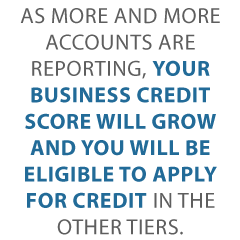
Once you get net terms and start making payments, these starter vendors will report those payments to the credit reporting agencies, also knowns as CRAs. If you have set up your business as a separate entity and set up your vendor account with your business information, they will report your payments to the business CRAs. As more and more accounts are reporting, your business credit score will grow and you will be eligible to apply for credit in the other tiers.
Hit the jackpot with our best webinar and its trustworthy list of seven vendors who can help you build business credit.
The Retail Credit Tier
This is where you find store specific cards. They like to see a minimum business credit score, which is why you apply for them after the vendor credit tier. The vendor credit tier is how you establish that initial score. You’ll need to get 8 or so of these accounts reporting your payments to the business CRAs before you can start applying for cards in the next tier.
The Fleet Credit Tier
These are the cards that help you manage fuel and auto maintenance and repair costs. They come from companies like Fuelman and Shell. You’ll need several of these reporting payments along with the cards from the retail credit tier before you can move on to the cash credit tier.
The Cash Credit Tier
This is where pretty much every best small business credit card mentioned above will be found. As you work through the other tiers your credit score will build like a snowball rolling downhill. If you manage your credit properly, you’ll have a strong score that will qualify for any of these cards. It takes time, but if you want the best small business credit card for your business, you must build business credit.
Don’t Let the Best Small Business Card for You Slip Through Your Fingers
If you already qualify for cards in the cash credit tier, then use our research above as a starting point for your own research. If you need to build business credit first, follow our proven process and you will be eligible for any of these cards when the time comes.
The post The Best Small Business Credit Card of 2019 for Any Situation appeared first on Credit Suite.


